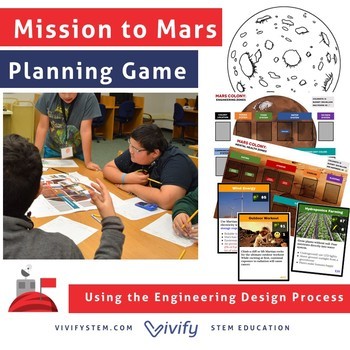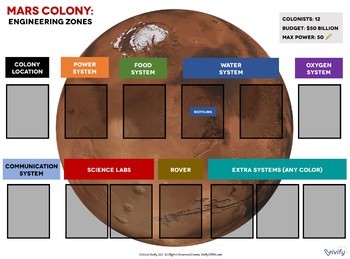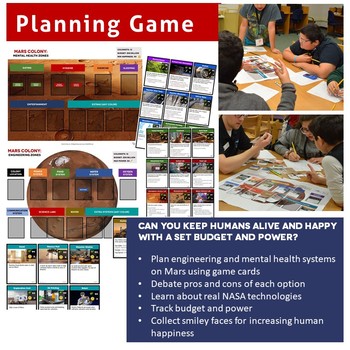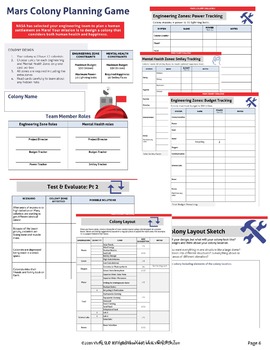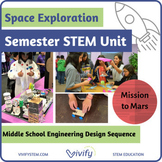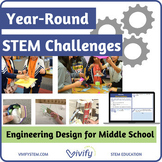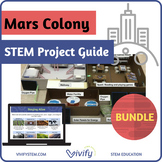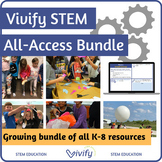Mission to Mars Planning Game (Mars Habitat STEM Project)
- PDF
What educators are saying
Also included in
- Need a semester-long STEM unit? This Mission to Mars bundle includes engineering design challenges building up to a capstone project of building a habitat on Mars! Lesson Overview Transform your classroom into a team of astronauts on a Mission to Mars! This STEM curriculum begins with Stage 1 team cPrice $67.00Original Price $83.75Save $16.75
- Space STEM Starter Challenges GROWING Bundle: Upper Elementary & Middle School STEMLaunch your students into STEM with these space-themed STEM challenges that incorporate the engineering design process. This mega bundle includes engaging STEM activities for space activities and design challengesPrice $226.72Original Price $283.40Save $56.68
- Are you in need of year-round STEM activities? This growing bundle includes our most popular STEM lessons and engineering design challenges for middle school grades! Click here for more guidance on planning out a STEM class including a scope and sequence and example STEM curriculum map. Includes a SPrice $388.52Original Price $485.65Save $97.13
- Design a habitat on Mars with our STEM project guide! Take your STEM or STEAM classroom or program to the next level with this in-depth engineering design STEM challenge. Students will apply scientific concepts, math skills, critical thinking, research, and engineering design to plan a long term habPrice $33.00Original Price $38.75Save $5.75
- Are you in need of year-round STEM activities? This growing bundle includes ALL Vivify K-12 STEM lessons from team challenges, engineering design, semester-long STEM units, research projects, and more! Purchase everything for 20% off individual products! Here is a sample of what is included: Stage 1Price $990.24Original Price $1237.80Save $247.56
Description
Mars Colony Project Guide + Planning Game
Can you keep a team of colonists alive and happy on Mars? Students work in teams to complete the ultimate project-based learning STEM experience: planning a long-term settlement on Mars! These activities can be used as a companion to the Mars Colony Project, which provides handouts to guide students to brainstorm and plan design solutions for a Mars colony. This Mission to Mars Planning Game product dives deeper into possible colony solutions, adds an interactive and game-like planning tool, teaches about real-world NASA engineering solutions, and is useful for students with limited internet access.
Real-world STEM Connection
Through game cards, students are introduced to real NASA technologies such as hydroponics, solar tents, MOXIE oxygen generator, and more! Students also learn about exciting current events in space exploration including the recent NASA Insight landing probe that reached the surface of Mars. As students read each game card, they debate the pros and cons of real technologies to support their own mission to Mars.
As a student-driven assignment, the purpose of the teacher is to act as a facilitator. This product is based on a 2 month long project-based design competition where students research and develop prototypes for a colony on Mars. Prototypes are built from recycled materials and presented to STEM professionals for judging. The depth of this project is dependent on the available time frame and classroom needs.
Mission to Mars Project Overview
Students create colony teams and complete the Mission to Mars: Planning Game to determine design components of a colony on Mars. Students consider various design solutions on engineering systems (food, water, power, oxygen, communication, and science labs) and mental health considerations (social, hygiene, exercise, sleeping, and entertainment). For each system, students read background cards to weigh the pros and cons while staying within budget and power constraints and maximizing human happiness. Each solution card provides details that are based on real technologies being developed by NASA. Once the solutions are determined, students create a scale-model of a Mars colony to represent location and architectural components. Below are the different systems that teams will explore:
- Food
- Energy
- Water
- Air
- Communication
- Science Experiments
- Rovers
- Eating areas
- Hygiene
- Exercise
- Sleeping
- Entertainment
Mars Colony STEM Project Includes:
- Detailed teacher guide with links to resources
- Editable Teacher Slides, Digital Handouts, Student Journal
- Photos of colony prototypes and layouts for inspiration
- Mission to Mars Planning Game boards (with instructions to print on regular 8.5 x 11 paper)
- Mission to Mars Game Cards with real NASA technologies
- Mission to Mars Student Handouts
- Engineering Design Process posters
- Rubric
- NASA Mission to Mars Article
Looking for more STEM lessons? Our team of engineers and educators is dedicated to developing low-prep and high-quality STEM activities for any classroom! Click below to learn more:
- Vivify's Scope & Sequence + Standards Alignment
- Vivify's Resource Guide
- Learn about the 3 Stages of STEM
- Vivify STEM Membership
Customer Tips:
• Click the Green ★ to follow our store and get notifications of new products and freebies
• Leave feedback to receive TpT credit for use on future purchases
• Questions? Contact us in the Product Q&A section
♥ Connect With Us ♥
Email us: info@vivifystem.com

